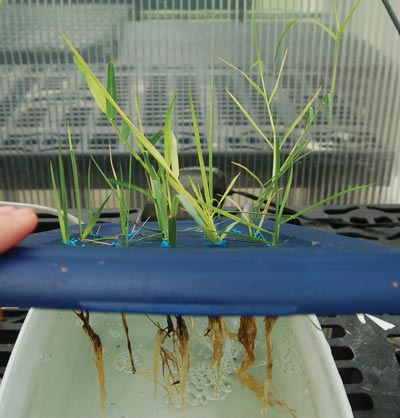
Historically, drought tolerance in turfgrasses has been tested using field evaluations under drought conditions. However, periods of drought are unpredictable and variable, which can hamper breeding programs focused on drought responses.
In this study, we aim to identify drought-tolerant zoysiagrass genotypes using a polyethylene glycol screening method in hydroponic systems. We grew 13 zoysiagrass (Zoysia species) genotypes (including entries germinated in polyethylene glycol) in hydroponic culture without polyethylene glycol (control) or with an increasing concentration of polyethylene glycol over the course of four weeks. The hydroponic cultures (no polyethylene glycol; polyethylene glycol) were split into the 13 genotypes comprising four commercial cultivars (Zeon, Icon, Palisades and Empire) and nine experimental lines.
During treatment, plants were evaluated for growth and morphological characteristics, including root emergence, root length density, root surface area, average root diameter, wilting and new leaf production.
Analysis of two trials of this experiment resulted in no differences between polyethylene glycol treatments. Genotypes were different for several characteristics, but there was no genotype × polyethylene glycol interaction. Genotypic differences were seen with root length, root surface area, average root diameter, number of shoots and leaves produced, root emergence, and wilting.
The lack of an interaction between genotypes and polyethylene glycol treatment indicated that the polyethylene glycol concentrations used in this study were not sufficient to cause differences in plant responses. However, the study does provide supportive evidence that a hydroponic system is an effective means for identifying differences in root and shoot responses between genotypes.
— Katherine Cox; John Erickson, Ph.D.; Esteban F. Rios, Ph.D.; and Kevin E. Kenworthy, Ph.D., University of Florida, Gainesville, Fla.; and J. Bryan Unruh, Ph.D., University of Florida West Florida Research & Education Center, Jay, Fla.
Editor’s note: An earlier version of this summary was published in the 2018 ASA-CSSA Meeting Abstracts, ASA and CSSA, Madison, Wis.
Teresa Carson is GCM’s science editor.